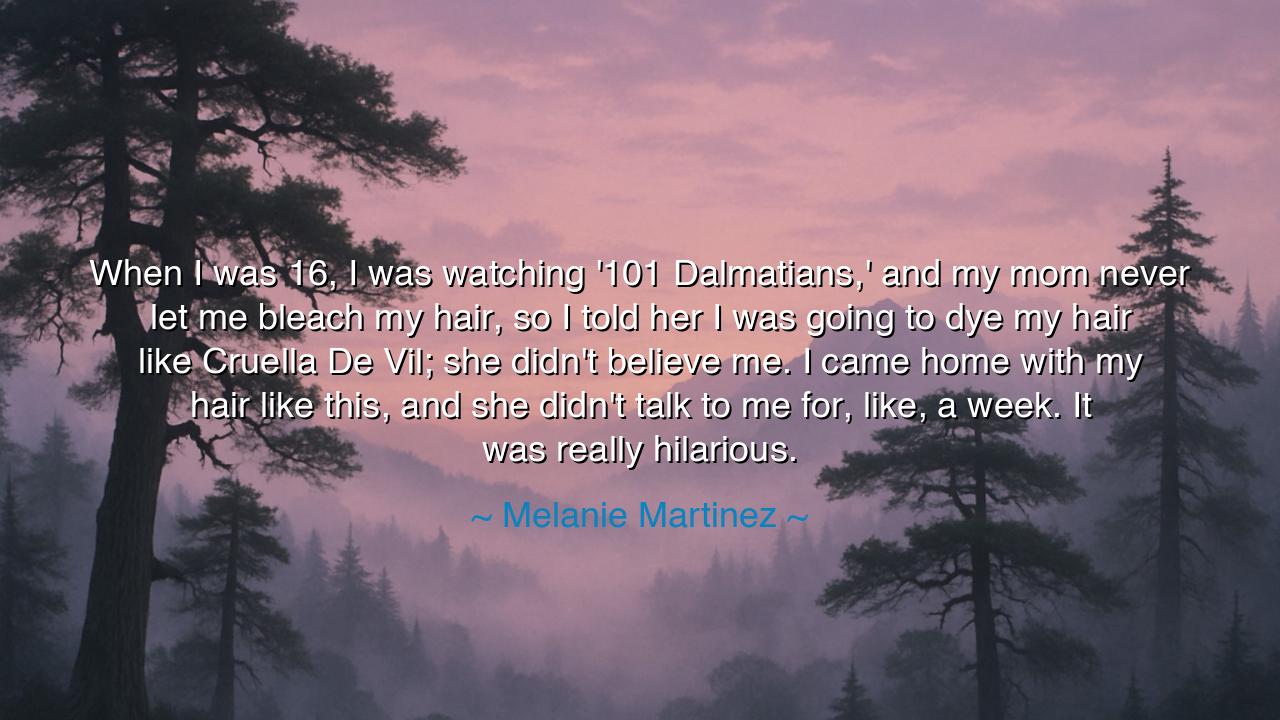
When I was 16, I was watching '101 Dalmatians,' and my mom never
When I was 16, I was watching '101 Dalmatians,' and my mom never let me bleach my hair, so I told her I was going to dye my hair like Cruella De Vil; she didn't believe me. I came home with my hair like this, and she didn't talk to me for, like, a week. It was really hilarious.






“When I was 16, I was watching 101 Dalmatians, and my mom never let me bleach my hair, so I told her I was going to dye my hair like Cruella De Vil; she didn't believe me. I came home with my hair like this, and she didn't talk to me for, like, a week. It was really hilarious.” Thus spoke Melanie Martinez, the songstress of rebellion and vulnerability, whose art turns defiance into poetry. Beneath the laughter of her memory lies a radiant truth about identity, courage, and the fire of youth. Her story, though light-hearted in tone, reflects a timeless struggle: the battle between self-expression and conformity, between the call of the inner spirit and the expectations of those who love us most.
At sixteen, the soul awakens to its own power. It begins to hunger for freedom, for the right to define itself, to wear not the colors of its parents or peers, but those of its own choosing. Melanie’s act of dying her hair like Cruella De Vil, half black and half white, was not a rebellion against her mother alone, but against the world’s unspoken command to be ordinary. In her boldness, she claimed the right to be different, even if that difference invited disapproval. The laughter with which she recalls her mother’s silence is not mockery, but triumph—the triumph of a young heart learning to stand firm in its own eccentricity.
To dye one’s hair may seem trivial, but in truth, such acts often mark the first declarations of independence. Since ancient times, people have adorned themselves to signify transformation. The warriors of old painted their faces before battle; the priests of Egypt shaved their heads before entering the temples; the artists of the Renaissance grew their hair long as a sign of devotion to beauty rather than war. In each gesture was a message: I belong to myself. So too was Melanie’s choice a rite of passage—the outward sign of an inner awakening.
The character she chose, Cruella De Vil, adds yet another layer of meaning. In the story, Cruella is a symbol of extravagance and boldness, a woman unafraid to shock, to defy, to live by her own fierce will. Though a villain in the tale, she embodies the unapologetic daring that society often condemns, especially in women. To emulate her hair was not to embrace cruelty, but to channel courage—the courage to say, “I am not what you expect me to be.” Thus, what began as a mischievous impulse became an act of symbolic rebellion, a proclamation of selfhood through the language of color.
Consider, too, the ancient tale of Antigone, the daughter of Oedipus, who defied the king’s decree to honor her brother’s memory. Though her act led to tragedy, her spirit was immortalized as a symbol of integrity—the refusal to betray one’s truth, even under threat of punishment. Melanie’s act, though far gentler, springs from the same source: the soul’s refusal to live only in the image of another’s will. Every generation has its Antigones—those who break a rule not out of spite, but to honor the truth of who they are.
Yet her story also reminds us of love’s complexity. Her mother’s silence for a week speaks not of hatred, but of the shock that love feels when it meets change. Parents, too, struggle when their children shed the familiar and become something new. What feels like rebellion to the young is often heartbreak to the old, for they see in it the loss of control, the fading of the child they once guided. But this silence, painful though it is, is part of the sacred dance between generations—the eternal rhythm of separation and reunion. Time, and laughter, often heal what pride and surprise once divided.
Thus, Melanie Martinez’s story becomes a parable for all who seek to create themselves in the face of expectation. It teaches that the path to authenticity is rarely smooth, that even love will sometimes resist it, and that humor—her laughter at the end—is the balm that transforms conflict into connection. For to laugh at one’s rebellion is to make peace with it, to see that growth need not breed bitterness, and that freedom, once claimed, can coexist with affection.
So, my children of expression, remember this: to be true to yourself is to risk misunderstanding, but that is the price of living sincerely. Do not fear the silence of others when you walk your own path; it is only the echo of their astonishment at your courage. Let your choices, however small—a color, a word, a song—be the signature of your soul upon the world. For the world changes not through obedience, but through originality. And when those who once doubted you finally see the beauty in your difference, they will understand—as Melanie did—that even rebellion, when guided by the heart, can become a work of art.






AAdministratorAdministrator
Welcome, honored guests. Please leave a comment, we will respond soon